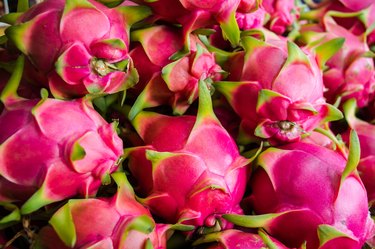
Dragon fruit, named for its vibrant, spiky skin, is sometimes known as pitaya and is primarily grown in Mexico and Central and South America. Dragon fruit can also be found in Asian countries, such as Thailand and Malaysia and is a staple for Asian-inspired cooking. If you want to experience the sweet, seedy flesh of dragon fruit yourself, your best bet is an Asian market. There, you can examine the fruit to choose one that is ripe and ready for eating.
Step 1
Examine the outer skin of the dragon fruit. Dragon fruit is either bright pink or deep golden in color. Look for skin that is evenly colored and devoid of bruises and knife marks. While some variation in the skin is common, the fruit should generally be the same color all over. Splotchy could be a sign that the fruit is overripe.
Video of the Day
Step 2
Touch the stem of the dragon fruit. A brittle stem denotes an overripe fruit, so look for a stem with slight pliancy.
Step 3
Examine the leaves or the petals that cover the outside of the fruit. They should be brightly colored, without browning on the ends, another sign of overripe fruit.
Step 4
Press your finger into the skin of the dragon fruit. A perfectly ripe fruit will give slightly to the pressure, much like a ripe avocado or mango. If your finger presses into the fruit too easily or the fruit is too hard, choose another dragon fruit.
Step 5
Smell the dragon fruit, looking for a light and tropical aroma. This is a sign that the flesh inside will be ripe and sweet.
Step 6
Place your purchased dragon fruit on your counter at room temperature to ripen it for use. The fruit is ripe when the pink or yellow color of the exterior darkens, after which you can transfer the fruit into your refrigerator for up to five days.
Video of the Day